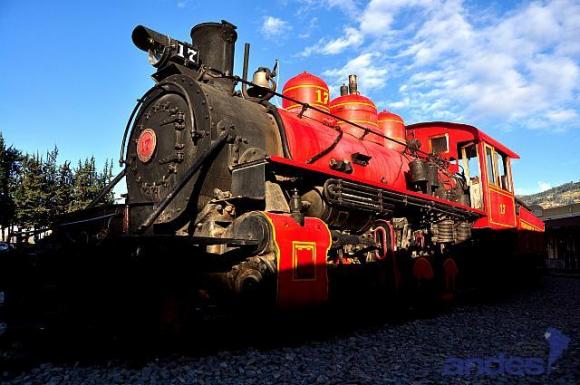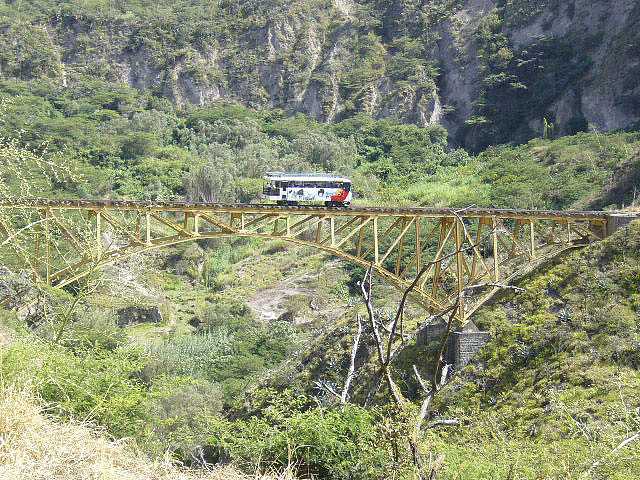After a leisurely breakfast at the hacienda in Otavalo, our driver took us along a newly built highway through villages and small towns on the way to Ibarra, at the base of the impressive Imbabura Volcano. Twenty-five minutes later, we arrived at the newly restored train station, renovated after years of neglect and disused railway services that began over a century ago. The train was an almost forgotten historic achievement until it was resurrected and enthusiastically restored by the Ecuadorian government two years ago. Our tickets had been reserved and purchased online several weeks previously, and we exchanged our payment receipt for a paper ticket at the Customer Service desk. Half an hour before departure time, we were called to board the Freedom Train (Tren de la Libertad) which celebrates both the freedom of the African slaves and Ecuador’s liberation from Spain. We alighted the charming colonial-style Carriage Number 207, a comfortable polished wood coach with adjustable upholstered seats – although slightly narrow to fit two larger western posteriors – and got comfortable. The air of excitement and anticipation throughout the carriage was tangible. We were accompanied by twenty giggling nuns, and four families with curious young children. Two other carriages, both painted bright red, were then boarded and the train driver tooted loudly, ready to go.
Before we departed from Ibarra, our guide Jaime introduced himself and, after a quick safety announcement, began to speak about the history of Ibarra and surrounds in both Spanish and English. Unfortunately, the English translations were a little shorter than the Spanish, and we heard less than half the information in English. When we commented about this to Jaime, he improved his translations. The train took us on a fun ride through lush green valleys and towering volcanoes, and the arid Andean savannah lining either side of the Andean River, all the while descending from an altitude of 2,210m at Ibarra to 1545m at Salinas. On the route from Ibarra to Salinas the landscapes are as diverse as they are picturesque; one of the country’s most fascinating ecosystems extends over the protected páramo El Ángel, a high-altitude forest of [native Australian] paper-bark trees and wild expanses of intriguing frailejón plants. We chugged past farmland dotted with fields of cabbages, cauliflower, lettuce and broccoli where farmers tilled their fields with horse-driven plows, cattle pastures, hillsides covered in wildflowers of all colors and varieties, medicinal herbs and flowers, prickly pears, several species of cactus and many pretty flowering succulents, alongside sugar cane fields, as well as spectacular waterfalls and the historical cotton fields, and finally the long-abandoned cotton processing plant on the edge of town. Over narrow bridges perched breathtakingly high above the river, and through half a dozen hand-built tunnels ranging from 26m to 300m which threw us all into pitch darkness for a few moments, and we arrived in Salinas two hours later.
The wonderful Freedom Train excursion is complemented by an interesting community-tourism twist that allows the Afro-Ecuadorian residents of Salinas to demonstrate their culture and history through dance and music. We are then refreshed by a delicious glass of chilled cactus juice in the station cafe and have time to wander through the craft shop at the train station before heading into the town square with a native guide for a peek inside the local church, which is 189 years old, and the community produce store, founded by a cooperative of growers who produce jams, sauces, chocolates, nuts, liquors and natural ice-creams from their own harvests. After sampling the Salinas version of Pina Colada and buying an ice-cream each, we wandered through the streets to our lunch stop. The Northern Andean village of Salinas has a population of around 2000 inhabitants, all descended from the slaves of the Spanish conquistadors who were stolen from Africa to work the cotton fields. Most of the inhabitants carve out a living from agriculture; cotton, sugar cane, and fruit for wines and preserves, retaining many of their original African traditions such as the ‘bomba’ music and dance.
Lunch is served in a large restaurant on the edge of the village, overlooking the fields with views of the mountains behind. A traditional almuerzo (set lunch) offered a choice of soups and chicken or meat dishes with rice, as well as a fresh fruit juice and small dessert for $5.00 per person. Chatter filled the room as people discussed the journey so far with great pleasure and satisfaction. Our local guide returned to give us a tour of the Salt Museum where he made a fascinating presentation of the mining and production of salt from the nearby mines, demonstrating how his ancestors used age-old methods and antique equipment to extract the salt and the excess iodine from the final product. After a taste of Salinas’ mountain salt, we wandered back through town to the train station via another route to board the train for the return trip home. Jaime took a break from guiding for the trip back and many dozed as we passed by the same landscape filled with numerous species of bromeliads, flowering prickly pear and other colorfully flowering plants and grasses. Our driver was there to meet us and return us to the hacienda, something we were grateful for after a long but wonderful day touring the Northern Andes.
If you are visiting Ecuador, a train tour on the newly renovated railways is highly recommended.


